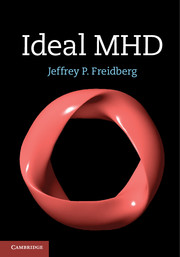Book contents
- Frontmatter
- Dedication
- Contents
- Preface
- Acknowledgements
- 1 Introduction
- 2 The ideal MHD model
- 3 General properties of ideal MHD
- 4 MHD equilibrium: general considerations
- 5 Equilibrium: one-dimensional configurations
- 6 Equilibrium: two-dimensional configurations
- 7 Equilibrium: three-dimensional configurations
- 8 MHD stability – general considerations
- 9 Alternate MHD models
- 10 MHD stability comparison theorems
- 11 Stability: one-dimensional configurations
- 12 Stability: multi-dimensional configurations
- Appendix A Heuristic derivation of the kinetic equation
- Appendix B The Braginskii transport coefficients
- Appendix C Time derivatives in moving plasmas
- Appendix D The curvature vector
- Appendix E Overlap limit of the high β and Greene–Johnson stellarator models
- Appendix F General form for q(ψ)
- Appendix G Natural boundary conditions
- Appendix H Upper and lower bounds on δQKIN
- Index
3 - General properties of ideal MHD
Published online by Cambridge University Press: 05 July 2014
- Frontmatter
- Dedication
- Contents
- Preface
- Acknowledgements
- 1 Introduction
- 2 The ideal MHD model
- 3 General properties of ideal MHD
- 4 MHD equilibrium: general considerations
- 5 Equilibrium: one-dimensional configurations
- 6 Equilibrium: two-dimensional configurations
- 7 Equilibrium: three-dimensional configurations
- 8 MHD stability – general considerations
- 9 Alternate MHD models
- 10 MHD stability comparison theorems
- 11 Stability: one-dimensional configurations
- 12 Stability: multi-dimensional configurations
- Appendix A Heuristic derivation of the kinetic equation
- Appendix B The Braginskii transport coefficients
- Appendix C Time derivatives in moving plasmas
- Appendix D The curvature vector
- Appendix E Overlap limit of the high β and Greene–Johnson stellarator models
- Appendix F General form for q(ψ)
- Appendix G Natural boundary conditions
- Appendix H Upper and lower bounds on δQKIN
- Index
Summary
Introduction
This chapter presents a discussion of the basic properties of the ideal MHD model. These properties include the general conservation laws satisfied by the model as well several types of boundary conditions that are of interest to fusion plasmas. The discussion demonstrates the physical foundations of ideal MHD while providing insight into its reliability in predicting experimental behavior.
The material is organized as follows. First, a short description is given of the three most common types of boundary conditions that couple the plasma behavior to the externally applied magnetic fields: (1) plasma surrounded by a perfectly conducting wall; (2) plasma isolated from a perfectly conducting wall by an insulating vacuum region; and (3) plasma surrounded by a vacuum with embedded external coils. The most complex of these provides a quite accurate description of realistic experimental conditions.
Second, it is shown that despite the significant number of approximations made in the derivation of themodel, idealMHD still conserves mass, momentum, and energy, both locally and globally. This is one basic reason for the reliability of the model.
Finally, a short calculation shows that as a consequence of the perfect conductivity assumption, the plasma and magnetic field lines are constrained to move together; that is, the field lines are “frozen” into the plasma. This leads to important topological constraints on the allowable dynamical motions of the plasma. In fact the property of “frozen-in” field line topology can be taken as the basic definition of “ideal” MHD.
- Type
- Chapter
- Information
- Ideal MHD , pp. 39 - 57Publisher: Cambridge University PressPrint publication year: 2014



